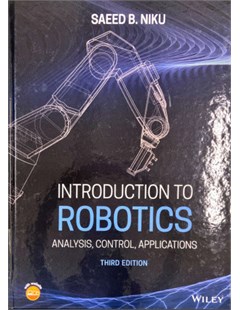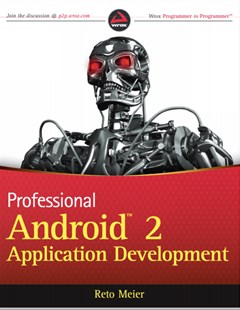Introduction to Robotics : Analysis, control, applications
Introduction to Robotics gives engineering students and practicing engineers the information needed to design a robot, to integrate a robot in appropriate applications, or to analyze a robot. The updated third edition contains many new subjects and the content has been streamlined throughout the text. The new edition includes two completely new chapters on screw-based mechanics and parallel robots. The book is filled with many new illustrative examples and includes homework problems designed to enhance learning.
2020
The revised and updated third edition of Introduction to Robotics: Analysis, Control, Applications, offers a guide to the fundamentals of robotics, robot components and subsystems and applications. The author—a noted expert on the topic—covers the mechanics and kinematics of serial and parallel robots, both with the Denavit-Hartenberg approach as well as screw-based mechanics. In addition, the text contains information on microprocessor applications, control systems, vision systems, sensors, and actuators.
Introduction to Robotics gives engineering students and practicing engineers the information needed to design a robot, to integrate a robot in appropriate applications, or to analyze a robot. The updated third edition contains many new subjects and the content has been streamlined throughout the text. The new edition includes two completely new chapters on screw-based mechanics and parallel robots. The book is filled with many new illustrative examples and includes homework problems designed to enhance learning.
Offers a revised and updated guide to the fundamental of robotics
Contains information on robot components, robot characteristics, robot languages, and robotic applications
Covers the kinematics of serial robots with Denavit-Hartenberg methodology and screw-based mechanics
Includes the fundamentals of control engineering, including analysis and design tools
CONTENTS
1 Fundamentals
1.1 Introduction
1.2 What is a Robot?
1.3 Classification of Robots
1.4 What is Robotics?
1.5 History of Robotics
1.6 Advantages and Disadvantages of Robots
1.7 Robot Components
1.8 Robot Degrees of Freedom
1.9 Robot Joints
1.10 Robot Coordinates
1.11 Robot Reference Frames
1.12 Programming Modes
1.13 Robot Characteristics
1.14 Robot Workspace
1.15 Robot Languages
1.16 Robot Applications
1.17 Other Robots and Applications
1.18 Collaborative Robots
1.19 Social Issues
1.20 Summary
References
Problems
2 Kinematics of Serial Robots: Position Analysis
2.1 Introduction
2.2 Robots as Mechanisms
2.3 Conventions
2.4 Matrix Representation
2.5 Homogeneous Transformation Matrices
2.6 Representation of Transformations
2.7 Inverse of Transformation Matrices
2.8 Forward and Inverse Kinematics of Robots
2.9 Forward and Inverse Kinematic Equations: Position
2.10 Forward and Inverse Kinematic Equations: Orientation
2.11 Forward and Inverse Kinematic Equations: Position and Orientation
2.12 Denavit-Hartenberg Representation of Forward Kinematic Equations of Robots
2.13 The Inverse Kinematic Solution of Robots
2.13.1 General Solution for Articulated Robot Arms
2.14 Inverse Kinematic Programming of Robots
2.15 Dual-Arm Cooperating Robots
2.16 Degeneracy and Dexterity
2.17 The Fundamental Problem with the Denavit-Hartenberg Representation
2.18 Design Projects
2.19 Summary
References
Problems
3 Robot Kinematics with Screw-Based Mechanics
3.1 Introduction
3.2 What is a Screw?
3.3 Rotation about a Screw Axis
3.4 Homogenous Transformations about a General Screw Axis
3.5 Successive Screw-Based Transformations
3.6 Forward and Inverse Position Analysis of an Articulated Robot
3.7 Design Projects
3.8 Summary
Additional Reading
Problems
4 Kinematics Analysis of Parallel Robots
4.1 Introduction
4.2 Physical Characteristics of Parallel Robots
4.3 The Denavit-Hartenberg Approach vs. the Direct Kinematic Approach
4.4 Forward and Inverse Kinematics of Planar Parallel Robots
4.5 Forward and Inverse Kinematics of Spatial Parallel Robots
4.6 Other Parallel Robot Configurations
4.7 Design Projects
4.8 Summary
References
Problems
5 Differential Motions and Velocities
5.1 Introduction
5.2 Differential Relationships
5.3 The Jacobian
5.4 Differential versus Large-Scale Motions
5.5 Differential Motions of a Frame versus a Robot
5.6 Differential Motions of a Frame
5.7 Interpretation of the Differential Change
5.8 Differential Changes between Frames
5.9 Differential Motions of a Robot and Its Hand Frame
5.10 Calculation of the Jacobian
5.11 How to Relate the Jacobian and the Differential Operator
5.12 The Inverse Jacobian
5.13 Calculation of the Jacobian with Screw-Based Mechanics
5.14 The Inverse Jacobian for the Screw-Based Method
5.15 Calculation
Saeed B. Niku, Introduction to Robotics : Analysis, control, applications, Wliley, 2020
 |  |  |
| Professional Android 2 Application Development | Unity 2017 Game Optimization second edition |
Thứ Tư, 18:42 01/03/2023
Copyright © 2018 Hanoi University of Industry.